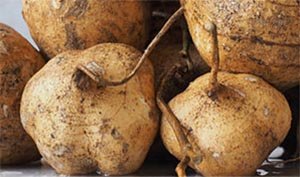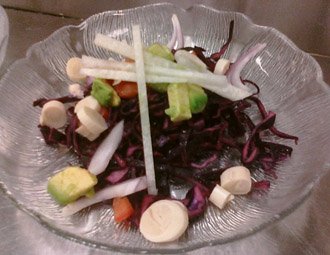Jicama (yam bean) Nutrition facts
Jicama, also known as yam bean, is a round, fleshy taproot vegetable or bean family plant. Its underground starchy root is one of the popular edible tuber-vegetables grown in many parts of Central America, South Asia, the Caribbean, and some Andean South American regions.
Its refreshing, crispy ice-white, fruit-flavored tuber can be eaten raw or cooked in a variety of sweet as well as savory dishes worldwide.
Scientific name: Pachyrhizus erosus.
 |
| Jicama roots (P.erosus). |
Some of the common names of yam beans are Mexican water chestnut, Mexican turnip, Seng Kwang, and yacon. It is pronounced in the Latin America as hecama. In India and Bangladesh, this tuber is popular as shank aloo-(শাঁখ আলু) or shankalu.
Jicama is a perennial vine, growing vigorously under semitropical and tropical climates. It has similar growth characteristics as that of lima bean or any other bean species plant. The most distinguishing feature, however, is that it bears globular, fleshy, turnip-like starchy edible roots below the ground surface. Unlike other starchy tubers such as potato, and sweet potato wherein the peel may be eaten; jicama features thick rust-brown inedible skin.
Inside, its white starchy flesh has a crispy texture and fruit-like delicious, sweet flavor. Each tuber weighs about 250 to 1200 g.
There exist at least five different cultivar types of Pachyrhizus species; however, only three popular jicama cultivars include Pachyrhizus erosus (Mexican yam bean), Pachyrhizus ahipa (Andean yam bean), and Pachyrhizus tuberosus (Amazonian yam bean, jíquima). P. erosus (‘jícama de leche’) or Mexican yam bean is the popular variety imported in the USA. Another cultivar, P. palmatilobus, locally known as ‘jícama de leche,’ has deeply lobed leaflets, milky sap, and a somewhat less pleasant taste.
Health benefits of Jicama
Jicama is one of the very low-calorie root vegetables. It holds only 35 calories per 100 g. Nonetheless, its high-quality phyto-nutrition profile comprises dietary fiber and antioxidants in addition to small proportions of minerals and vitamins.
It is one of the finest sources of dietary fiber; particularly excellent source of oligofructose inulin, a soluble dietary fiber. The root pulp provides 4.9 mg or 13% of fiber. Inulin is a zero-calorie sweet inert carbohydrate. It does not undergo metabolism inside the human body which makes jicama an ideal sweet snack for diabetics and dieters.
As in turnips, fresh yam bean tubers are also rich in vitamin-C; provide about 20.2 mg or 34% of DRA of vitamin-C per 100 g. Vitamin C is a powerful water-soluble antioxidant that helps the body scavenge harmful free radicals, thereby offering protection from cancers, inflammation, and viral cough and cold.
It also contains small levels of some of the valuable B-complex group of vitamins such as folates, riboflavin, pyridoxine, pantothenic acid, and thiamin.
Further, the root provides healthy amounts of some of the essential minerals like magnesium, copper, iron, and manganese.
| Principle | Nutrient Value | Percent of RDA |
|---|---|---|
| Energy | 38 Kcal | 2% |
| Carbohydrates | 8.82 g | 7% |
| Protein | 0.72 g | 1% |
| Total Fat | 0.19 g | <1% |
| Cholesterol | 0 mg | 0% |
| Dietary Fiber | 4.9 g | 13% |
| Vitamins | ||
| Folates | 12 μg | 3% |
| Niacin | 0.200 mg | 1.5% |
| Pantothenic acid | 0.135 mg | 3% |
| Pyridoxine | 0.042 mg | 3% |
| Riboflavin | 0.029 mg | 2% |
| Thiamin | 0.020 mg | 2% |
| Vitamin A | 21 IU | 1% |
| Vitamin C | 20.2 mg | 34% |
| Vitamin E | 0.46 mg | 3% |
| Vitamin K | 0.3 μg | <1% |
| Electrolytes | ||
| Sodium | 4 mg | <1% |
| Potassium | 150 mg | 3% |
| Minerals | ||
| Calcium | 12 mg | 1% |
| Copper | 0.048 mg | 5% |
| Iron | 0.60 mg | 7% |
| Magnesium | 12 mg | 3% |
| Manganese | 0.60 mg | 3% |
| Zinc | 0.16 mg | 1% |
| Phyto-nutrients | ||
| Carotene-ß | 13 µg | -- |
| Carotene-&alfa; | 0 µg | -- |
| Lutein-zeaxanthin | 0 µg | -- |
Selection and storage
Jicamas can be available year-round in the markets. Generally, they are imported from Central American countries through land routes and flood the USA markets during spring and summer.
Choose well-formed, firm, round, medium-sized tubers. Avoid soft, shriveled, or tubers with surface cuts, cracks, and bruised skin.
Once at home, jicamas can be stored much like potatoes. They have a good shelf life and keep well in a cool, dry, dark place for about 2-4 weeks. Exposure to a temperature below 10 °C results in chill-induced changes in color and texture. Also, prolonged storage converts its starch into sugar, which makes the roots less sought-after in savory dishes.
Cut sections, cubes, or slices, however, should be placed inside the refrigerator.
Preparation and serving methods
Wash in cool running water and dry mop just like in other tubers. Peel off the thick fibrous skin using a vegetable peeler or paring knife. Skin and other plant parts carry rotenone, an organic poison, and therefore, should be discarded. It then can be cut into cubes, sliced, or chopped into fine strips in the ways desired.
Fresh jicama is used much like a vegetable and is an important starch source in much of Central America. It stays crisp when cooked, making it one of the wonderful vegetables in stir-fries.
Here are some serving tips:
 |
| Jicama salad. Photo courtesy: Rex roof |
-
Raw jicama has sweet, succulent apple like fruity taste. In many parts of Mexico, fresh tubers are cut into cubes/sticks and sprinkled with lime juice, salt, and dressed with olive oil and paprika or ground chili pepper and enjoyed!
-
Jicama is a favorite root vegetable in Mexican cooking where it is used in salads, slaw, stews, stir-fries, soups, etc. It mixes well with other common vegetables and fruits like orange, pineapple, carrot, green beans as well as with poultry, meat, and seafood.
Outside of the American continent, this tuber is among the popular starch roots in many south and southeast regions. In Malaysia, where it is known as bengkoang, fresh young tubers are sliced and eaten with other fruits like pineapple, apple, raw mango, sweet potato, etc, in rujak.
In Indonesia, they served with much like Malayan salad but with added rujak sauce made from palm sugar, tamarind, shrimp paste, chili peppers, and sautéed peanut paste. Also, as a rujak tumbuk, all the ingredients mentioned above are ground in a wooden mortar and served on a banana leaf.
In Eastern India states of West Bengal, Odisha, and Bangladesh, shankaalu is eaten as mouth-watering street food 'chaat recipe' paired with starfruit, chili and salt powder and lemon juice.
Apart from salads, another popular oriental dish that uses jicama and turnips is popiah, a Fujian/Chaozhou-style fresh spring roll.
Safety profile
Jicama plant contains significant levels of fat-soluble organic toxin, rotenone. This toxin is concentrated especially in the leaf tops, stems, and seed pods but at much lower concentrations in the roots. Several studies found that it is linked to the development of Parkinson's disease.
However, peeled roots are safe for human consumption, including in children. Rotenone works at the cellular level inhibiting several metabolic enzymes like NADH dehydrogenase in the mitochondria. Outside, it is used as an environmentally safe broad-spectrum insecticide, piscicide (to poison fish), and pesticide. (Medical disclaimer).
≻≻-Back to Vegetables from Jicama nutrition. Visit here for an impressive list of vegetables with complete illustrations of their nutrition facts and health benefits.
≻≻-Back to Home page.
Further Resources:
Stanford School of Medicine Cancer information Page- Nutrition to Reduce Cancer Risk.
Norton, L. B. 1943. Rotenone in the yam bean (Pachyrrhizus erosus).
Quantification of rotenone in seeds of different species of yam bean (Pachyrhizus sp.) by a SPE HPLC–UV method. PDF.